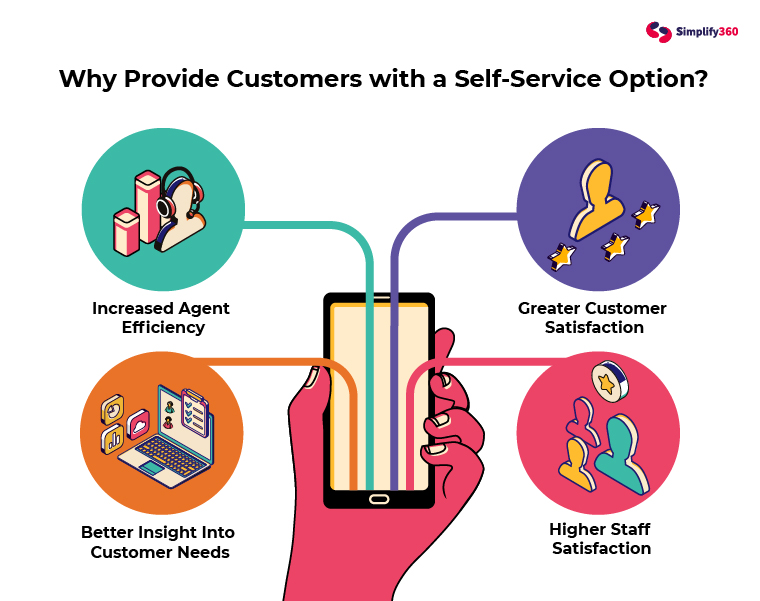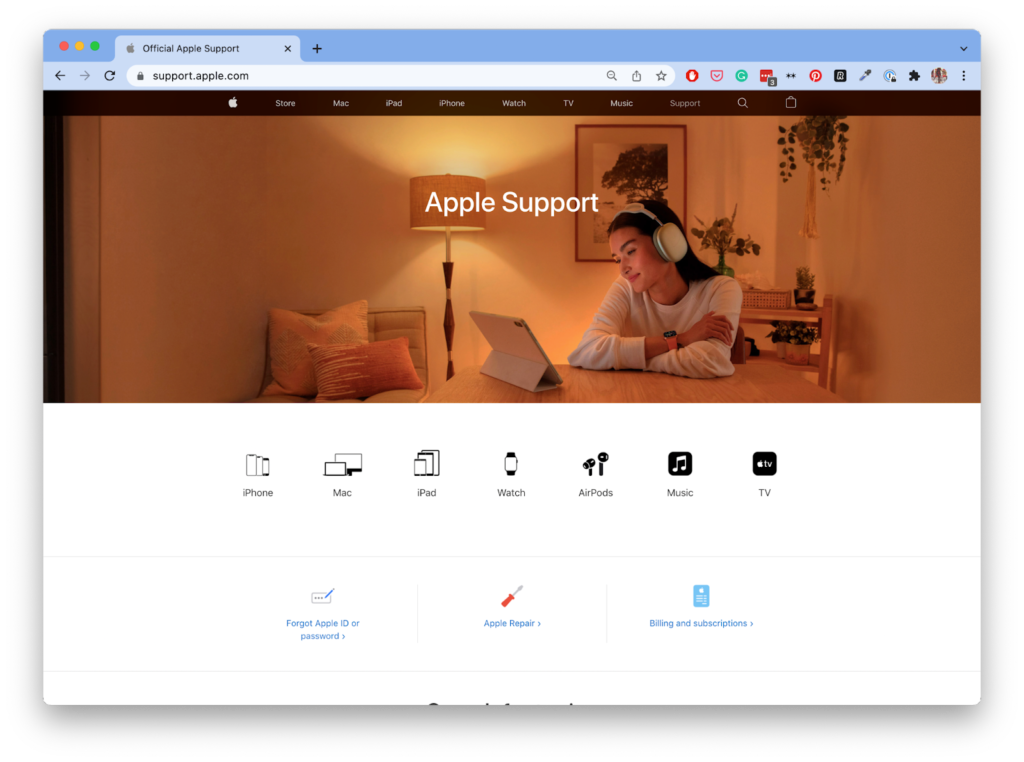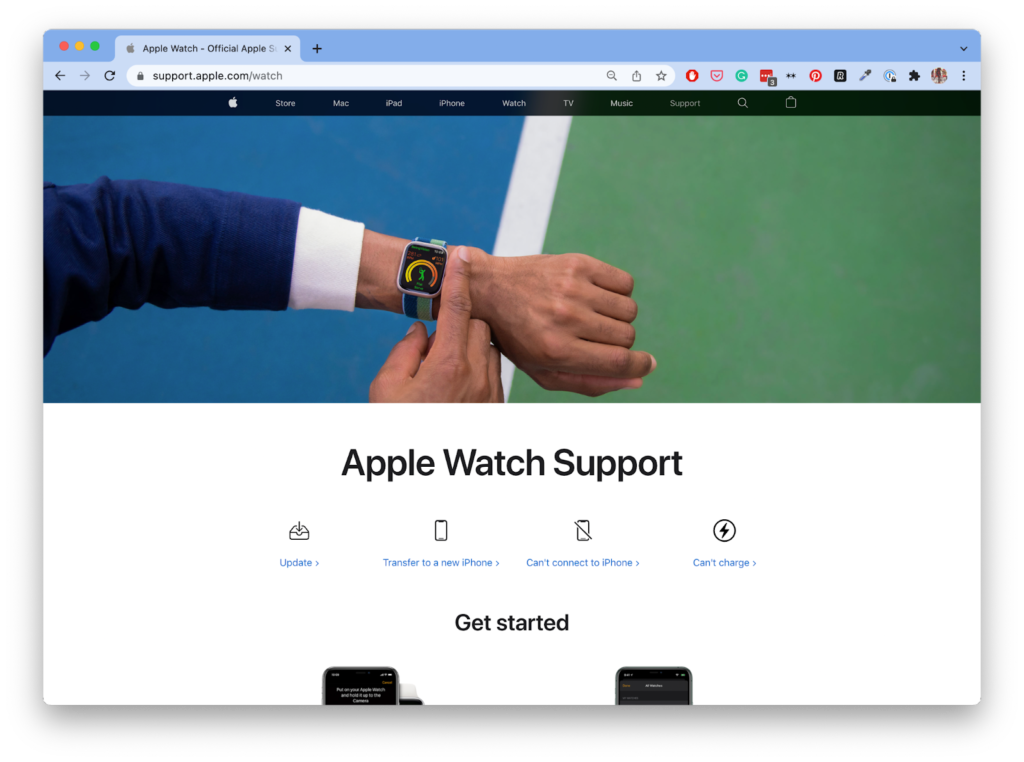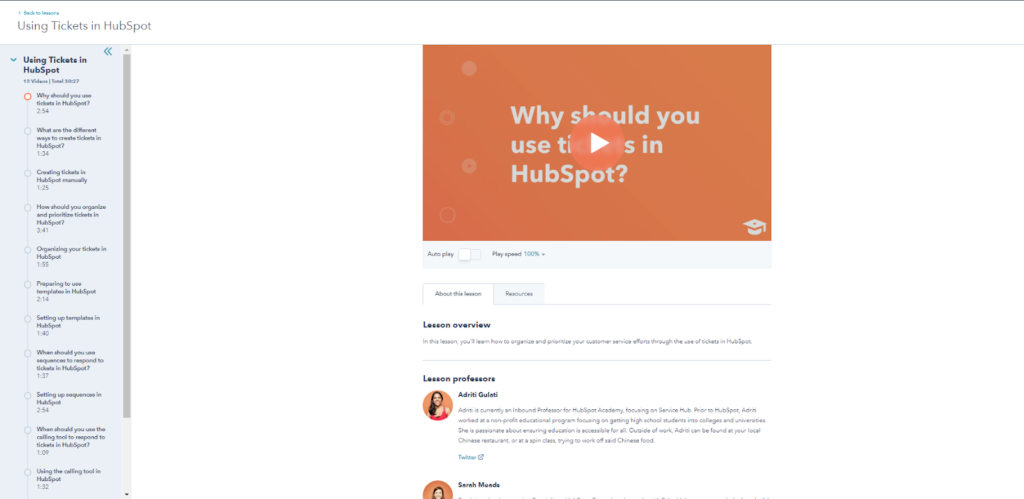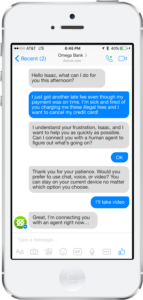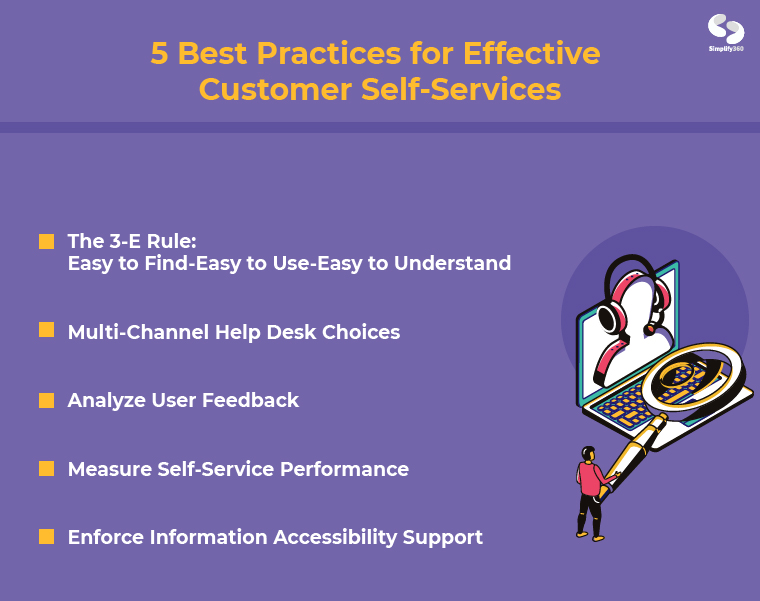The best way to help your customers is by providing them with self-service options.
The modern customer isn’t the one to wait around the clock for you to provide them with answers. They prefer to have everything available at their fingertips. From product details to guarantee/warranty details, modern customers derive a sense of achievement in finding solutions to their problems.
Amongst the different types of customers, ‘The Researchers’ are the ones that demand your attention the most. This category of customers is independent and wants to explore every option available. It is quite possible that they have looked for every possible solution before reaching out to your agent for support.
It is for this reason that we recommend providing your customers with all the support on your website. This assures that your customers stay within the walls you build. The more your customer strays, the higher the chances of losing your customer.
Having a self-service portal provides your customer with the information needed to solve repetitive queries.
Once your company masters the self-service you can cut down costs, increase agent efficiency and improve the overall experience for customers.
But for that, you need to start by understanding what customer self-service is.
What is Customer Self-Service?
In simple words,
“The process by which customers can resolve their own problems without external help from a support agent is known as Customer Self-Service.”
The explosive growth of eCommerce brands comes with increased competition and higher customer expectations. The impacts of the global lockdown that had almost crippled the world economy are not unknown to any. But, little do we know, the pandemic also eased the transition from the physical to the digital world.
Let us take one of the most easily seen examples of digital enabling and self-service that is the outcome of the global pandemic.
Have you tried catching a flight in the post-covid time? If yes, chances are you must be aware of the kiosk machine. Having kiosk machines installed in airports have reduced the fear among authorities as well as travelers of contracting the virus. At the same time, it provides the passengers with an opportunity to feel in charge of their trip.
Similarly, when brands enable self-service measures, it provides their customers with the opportunity to come up with their own solutions. In a recent survey done by Nuance Enterprise, it was found that almost 67% of customers prefer to use self-service options instead of speaking with agents.
Therefore, self-service simply means customers can complete an action or task on their own without any assistance from a company employee. It is a proactive customer service that aims at providing support for customers that are more inclined towards solving problems by themselves.
Irrespective of whether the customer wants to feel in charge or independent of their customer journey, self-serving measures can provide fast and readily available solutions.
Let us have a look at various reason that makes it a must-have feature on your platforms.
Why You Should Provide Self-Service Options?
Imagine having to pick up your phone every time you faced an issue with a product! And, the frustration doesn’t end there. One support phone call then turns to wait on hold! Would you prefer doing that even if you could have solutions right in front of you?
Being able to use your company resources enables your customers to look up answers to simple support questions.
Moreover, it also benefits your customer service team. Having self-help measures saves your agents’ time. They no longer have to deal with repetitive or similar cases. This reduces the stress on your incoming request queue.
Reducing support traffic means that customers with bigger problems can easily reach agents without long delays. Before we move on to see the real benefits of having customer self-service options, let’s have a look at its impact on CX.
How Self-Service Improves Customer Experience?
As we said earlier, customers today prefer to solve their own problems, And for that, they like to visit your website in search of all their answers.
Keep yourself in their shoe. Would you like to reach out to a support desk for the smallest of your queries?
Of course not!
You would rather appreciate a company making sure that all the mandatory information is available to you wherever you are.
Enabling your customers with their own help desk, available 24/7, improves your customer’s experience. It makes them feel seen, heard, and more importantly independent.
Here are 5 major benefits of customer self-service.
1. Greater Customer Satisfaction
It is quite understandable that faster response means happy customers. Reducing the response rate is one of the biggest targets for every successful customer-service brand.
Achieving this becomes easier with self-service.
Self-help features put your customers in control. It gives them fast access to information and answers. As a result, you get to achieve greater customer satisfaction.
2. Increased Agent Efficiency
Owing to the above given explanation of customer self-service, we know by now that it is the key for businesses to successfully manage customer queries.
In other words, boosting customer satisfaction alone no longer serves the purpose. As a modern brand, you need to aim for overall efficiency. This means empowering your agents as well.
With a self-service knowledge base or FAQ article, you can encourage your customers to find solutions to trivial queries on their own. This leaves plenty of room for your agents to deal with more complex customer queries.
3. Higher Staff Satisfaction
As we mentioned above, deflecting routine queries frees up your agents to handle complex interactions.
This leaves ample time for the support agent to deal with angry customers. They can use their skills such as empathy and understanding to their full potential. This not only benefits customers and business efficiency but also gives satisfaction to your agents.
If you are still looking for ways to incorporate empathy in your desk support, here is an article that might help you.
👉Empathy in Customer Service – Everything You Need to Know
The more your agents are able to work up to their best potential, the higher will be their performance chart.
4. Better Insight Into Customer Needs
Having measures for self-service means understanding your customers’ frequent pain points.
With the rapidly changing business landscape, it is almost impossible to expect what your customers might need. But, it is possible to adapt to your customer’s changing needs and deliver accordingly.
Customer self-service helps you analyze the frequent queries asked and address issues in your customers’ journey.
Best Examples of Effective Self-Service
By now, we have understood the importance and need of companies developing customers’ self-service strategies. Let us now help you with the best ways you can achieve that.
1. Knowledge Base
Knowledge Base is that section of your website that answers simple service questions for your customers.
It can include logistics of your products/services. But, above all else, the section provides informational articles that can help troubleshoot steps for common customer roadblocks. The most important benefit of having a knowledge base section is its accessibility to all.
It enables your team to record detailed steps for commonly raised questions, and share them with all.
Let’s take Apple Support for example.
Apple is known for its outstanding support and its knowledge base that promises delivery.
Their variety of products demands a support center that lets users ask for and choose relevant product information. You can also view this as their filtering mechanism which ensures that users only see relevant content.
Once the user has selected their product of choice, the website displays articles that it deems relevant to the user’s query.
The key takeaway from this is to always avoid confusion and save users time. If you have a complex product, it is crucial to find intuitive ways to guide your users to appropriate knowledge base content.
2. Product Training for Customers
Yes, you read that right!
We do believe in training your customers about your products as much as your agents.
It is true that product training benefits your service reps immensely. The training helps them understand not just your product/service but also your company values and policies. They get a detailed explanation of your product’s functions, common roadblocks, and the best ways to optimize a product for customer workflow.
In other words, product training helps your customer service reps become certified product experts.
But, if this works so well for your agents shouldn’t your customers be also offered the same training?
Now we understand that your customers do not need to become certified experts. But offering training on your product functions and services will improve their customer experience. Moreover, it becomes a marker of dedicated customer success.
Let’s take HubSpot’s Academy Courses for example.
The company offers free training in the form of video recordings. These recordings are posted on the Hubspot Academy homepage. Users can watch these videos, complete tasks, and familiarize themselves with the company’s products and marketing ideology.
3. Flexible Automation Features
Automation is the king of modern marketing. There!
Someone needed to say it.
Automation, as a feature, exists in every sector of industries. From the medical sector to banking, from customer support to sales every field of marketing incorporates automation.
Why?
The major reason automation is ubiquitous is its ability to save time and yet deliver precision, customers can use automation features like AI chatbots to help them find information fast. On the other hand, it can set up workflows that automatically send emails to customers and remind your agents to follow up on open cases.
Simplify360 provides you with AI technology that automates a major chunk of tickets. From sentiment tagging to resolutions, their AI Bot can be customized as per users’ needs. The product SimplyBot can identify intent from your customers’ input messages and then resolves queries.
You can know more about its features here.
4. Easy Options for Escalation
Until now, we have understood that customer self-service can look like many things. It can be the informational blogs you post on your website about your products or it can be something as simple and open as automating your work.
However, in 2019 Forrester said that customers would develop a backlash against chatbot support.
So are chatbots a lousy feature? Are they failing?
Its the quite the opposite honestly. What Forrester meant to highlight was the chatbot’s inability (back then) to offer escalation options during the chat. Imagine talking to chatbot support and not being able to transition into desk support at your will.
Even the image if it is enough to feel frustrated.
Not being able to shift to a customer support agent from chatbot support disrupts customers’ workflow. Especially when they are only looking for a quick clarification on particular product details.
Let’s take Omega Market for example.
The company uses a messenger tool that fields incoming service requests as chats. But, if the customers show an inclination towards escalating the issues, they can simply request to speak to a live agent, and the chatbot does so. Once the chat has undergone the transition, the rep can take over the issue raised by the customer.
Providing easy escalation is probably the best example of providing a seamless omnichannel experience to your customers.
5 Best Practices for Effective Customer Self-Service
Now that you know what are the best ways to implement customer self-service, here are 5 best practices for you to follow.
1. The 3-E Rule: Easy to Find, Easy to Use, Easy to Understand
It is important to remember that you instill self-service for your customers to help them.
Therefore, your self-service aids must be easy for them to access and understand. Its functionality depends on how easy your customers find it to use it. The lack of ease will not only frustrate your customers but will also increase your reach out to your support desk.
There are various things you can do to ensure an easy self-service measure.
First and foremost, your self-service portal should be easy to find. For this, you can either design your portal from scratch or you can invest in SEO. What is important is to make sure the knowledge and support pages are indexed and ranked so the customers can easily find them.
You can also categorize the display of information strategically. Displaying a large amount of information to users in the self-service application will overwhelm your customers. It makes them feel helpless. Focus on simplicity and use images for easy recognition.
Lastly, keep a check on the language used in your knowledge base. Your content must be easy to read. Avoid using industry jargon. Enriching your content with graphics, videos, and bolded text helps draw customers’ attention to important sections.
2. Multi-Channel Help Desk Choices
It is important that your self-service portal is offered across multiple channels. Remember that your customers are present everywhere, and they expect the same from you.
Integrate your various channels such as website, work community, instant chat, and phone/emails.
Once integrated your customers are automatically drawn towards using them as they understand the easy availability, moreover, it adds to their seamless omnichannel experience.
3. Analyze User Feedback
It is natural to be biased toward the efforts you put into developing your self-service application. You won’t probably see any flaws or demerits in it.
But, it is also important to remember that you as the developer or company insider already know everything inside out. A customer, on the other hand, is an outsider. And it is your job to make them feel like part of your family.
This is precisely why you must pay attention to user feedback. This of them as judges or mentors who can help you improve your platform.
To provide a great user experience, it is important that you understand what the audience wants! Following are a few ways you can gather information about customer wants
- User satisfaction survey
- Surveys that measure loyalty between your company and employees
- Web Analytics and search logs
- Customer feedback/individual answers
4. Measure Self-Service Performance
It is quite common for us all to chase a path with the least resistance. None of us wants a slow, awkward self-service experience. Such an experience has a higher chance of creating abandonment than loyalty. In other words, if your customer doesn’t feel that their time is resected. they might as well look for a substitute.
Therefore, to ensure the high performance of the self-service application, you must ensure that all the graphics you use are optimized. Healthy self-service rates may vary considerably, depending on the nature of your business. But, it is crucial to carefully watch the KPIs as these are the providers of the overall graph of self-service.
You must understand that measurement of self-service performance doesn’t ensure the performance of your product. It simply tells how well your customers are taken care of.
In other words, the lesser your customers reach your support desk, the better you have understood their common queries.
5. Enforce Information Accessibility Support
As we have emphasized this multiple times now, we hope you’ve understood its importance.
Making sure that the information you provide is accessible to your users is of utmost importance.
True accessibility means support for a variety of browsers and for assistive tech as well. While developing your knowledge support aim for inclusivity. This means developing tools that keep people with disabilities within the customer graphs as well. Good accessibility ensures maximum reach of your self-service content into the marketplace.
It ensures the success of the greatest possible number of users in a self-service task.
Conclusion
Customer self-service strategy is the next step in your customer service agenda.
It is the future of marketing. With more customers aiming to minimize contact with the support desk, self-service is the way to retain customers. With it, in place, you are more likely to win relapsing customers than ever before.
Self-service aids are the best friend that your business needs today. It can create a space for your customers to feel in power. We this guide, we have covered almost every question you can possibly think of that’s related to customer self-service.
All that’s left is for you to start implementing them!




